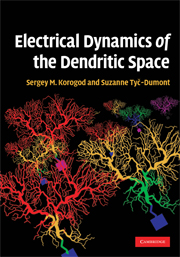Book contents
- Frontmatter
- Contents
- Preface
- 1 Definition of the neuron
- 2 3D geometry of dendritic arborizations
- 3 Basics in bioelectricity
- 4 Cable theory and dendrites
- 5 Voltage transfer over dendrites
- 6 Current transfer over dendrites
- 7 Electrical structure of an artificial dendritic path
- 8 Electrical structure of a bifurcation
- 9 Geography of the dendritic space
- 10 Electrical structures of biological dendrites
- 11 Electrical structure of the whole arborization
- 12 Electrical structures in 3D dendritic space
- 13 Dendritic space as a coder of the temporal output patterns
- 14 Concluding remarks
- Index
- References
7 - Electrical structure of an artificial dendritic path
Published online by Cambridge University Press: 03 May 2010
- Frontmatter
- Contents
- Preface
- 1 Definition of the neuron
- 2 3D geometry of dendritic arborizations
- 3 Basics in bioelectricity
- 4 Cable theory and dendrites
- 5 Voltage transfer over dendrites
- 6 Current transfer over dendrites
- 7 Electrical structure of an artificial dendritic path
- 8 Electrical structure of a bifurcation
- 9 Geography of the dendritic space
- 10 Electrical structures of biological dendrites
- 11 Electrical structure of the whole arborization
- 12 Electrical structures in 3D dendritic space
- 13 Dendritic space as a coder of the temporal output patterns
- 14 Concluding remarks
- Index
- References
Summary
The mathematical tools described in the preceding chapters can now be applied first to simple artificial structures for the sake of demonstration of the electrical relations between proximal and distal dendritic sites. Studying these relationships means analyzing the electrical states of the sites. In a dendritic cable, the local electrical state, that is the state of a site, is characterized by the transmembrane voltage, current and/or conductance. A set of values of voltage (current, conductance) defined at consecutive sites along a path forms the so-called path profile of the corresponding values. It is graphically represented by a plot of these values as a function of the path distance from the soma.
A single dendritic path has a unique dimension measured in units of distance along the dendrite. Electrical relationships between all the sites situated in this continuous one-dimension space at shorter or longer distances from the reference point, usually the soma, provide a one-dimension representation of the electrical structure of a path. The electrical relation between proximal and distal sites is the only type of spatial relationship that can be assessed by the electrical picture of a single path. As a single dendritic path (Figure 7.1) is the most simple building block of an arborization, its study provides basic insights into the complexity of the dendritic structure.
In this chapter, the impact of a variation in diameter on the electrical structure of a single dendritic path is analyzed in detail.
- Type
- Chapter
- Information
- Electrical Dynamics of the Dendritic Space , pp. 77 - 94Publisher: Cambridge University PressPrint publication year: 2009



